Spiced Pork Roast
Serve an elegant, but surprisingly easy, rolled and spiced pork roast, with a delicious gluten free seasoning inspired by the cooks of a king’s court!
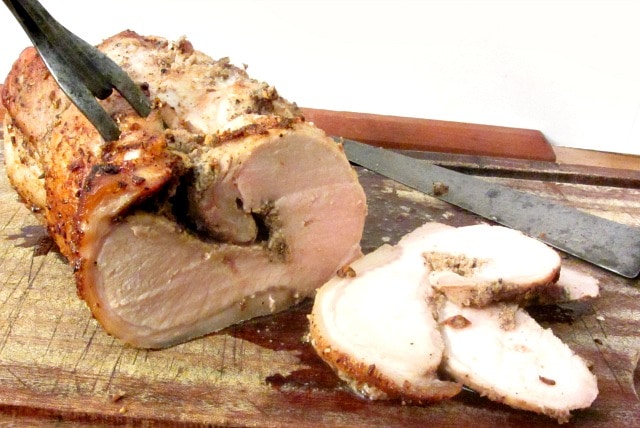
I have mentioned before that I enjoy studying historic recipes. I like to know the way people before me cooked and ate, just as I enjoy recipes from around the world. For my purposes, “historic recipes” can be from 1950s American cookbooks to the oldest recipes you can find. Sometimes I like to try to reproduce recipes as accurately as I can, and sometimes they serve to inspire me to create a new recipe.
One of the oldest I generally use is The Forme of Cury, from last 14th Century England. It exists in several manuscripts, attributed to “the chief Master Cooks of King Richard II.” A version was printed some 400 years later, and a copy of that is now readily available online. Recipes vary from simple bean recipes (favas, probably – most of our beans are New World) through a tossed salad (with greens we would mostly consider herbs, rather than vegetables) to venison and lobster.
And pork. I have made a recipe called Cormarye for years. It calls for marinating pork loin in a mixture of coriander and caraway, salt and pepper, ground with garlic and added to red wine. Then you roast the meat – and apparently make a sauce of the drippings and some broth, but that part isn’t quite as clear. (Do you use the marinade as well? Do you baste with it, in which case it would be in the drippings?) I just discard the marinade, as the meat itself is flavored beautifully… I never thought it needed a sauce. It’s terrific cold, too.
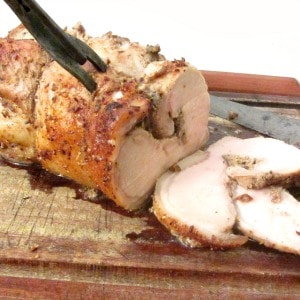
But I’ve had the idea kicking around in my mind for a while, of using the spice mixture for a rolled roast, similar to the Stuffed Pork Loin from a while back. The meat would be even more exposed to the spice mixture, you could use a much shorter marinating time, and it would look quite festive (while still being pretty easy.) So I played with that a bit and – oh, my, this is the most delicious and flavorful pork roast I’ve ever made… It is not the recipe as it was cooked in 1390 London – Authentic 21st Century New York here, as always, though with inspiration. Perfect for a slightly festive family dinner or a few guests – you prepare the roast a few hours earlier to let the spice permeate the meat, and then just pop it in the oven.
In the 14th Century, the most exotic spice in this would have been the pepper – caraway and coriander both grow in Europe, but pepper had to be imported. How times change! I really do recommend using whole spices, and grinding them fresh – pepper sitting out in a shaker loses flavor quickly. For some reason we don’t seem to use caraway much any more, though it is a classic European spice – we get it on rye bread, and sometimes sprinkle it on cabbage, and not much else. And we think of the coriander seed mostly in Indian cooking, but it’s been popular in Europe for centuries.
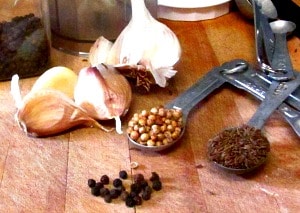
Take one teaspoon each of whole coriander and caraway, and half a teaspoon of peppercorns. (You can increase the pepper if you want it actively hot – I just went here for a mild tingle that won’t bother people who don’t care for real heat.) Grind them with a quarter teaspoon of salt. You can use a mortar and pestle, or a spice (coffee) grinder – I used a mini-chop that came with my immersion blender. The amount is too small for a regular blender. Then add garlic. My garlic cloves were huge! So I just used two – I’m going to say two to four, vary both by the size and by your love of garlic. This gave a distinct flavor (and it smelled so good roasting!)
The original recipe calls for red wine, and I’ve used that when I do the original marinade. But here, I just wanted a few spoonfuls to make a paste, so I opted for red wine vinegar instead. Partly, I’m not going to open a bottle of wine (or tell you to do so) for three tablespoons… but mostly because I did want a higher acid content using a rub, not a liquid marinade. It is there to help convey the seasoning into the meat, and vinegar works better, here. So add the garlic and vinegar to the spice mix, and blend until you have a smooth paste. Set that aside for the flavors to meld.

Now, here is the part that looks so fancy, but really is not difficult. First, do make sure you have something to tie the roast with. I have these silicone bands – just like rubber bands but oven safe and reusable and handy for a surprising number of kitchen tasks! Plain old traditional butcher’s twine works just fine, though, or you can use skewers to sort of pin everything together…
Lay the roast on your cutting board, and slice horizontally from the narrow side to – but not through – the thick side. Then open it out flat like a book. (You may need to slice just a little more to flatten it.) Now, take your knife, and stab the meat with the tip – you really want lots of little cuts all over, as they help the seasoning permeate the meat. (I actually use a paring knife for this – it feels less… violent… somehow, than stabbing furiously with a carving knife!)
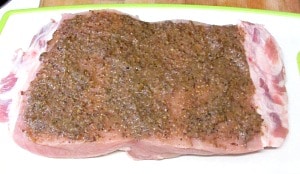
Then carefully spread the spice paste all over the surface of the meat, gently rubbing it in. And sorry – no picture of the next phase, I needed all available hands – but roll up the meat from the one narrow end. Now, the spice paste is wet enough that some will ooze out – don’t worry about that now. Once it is rolled secure it with your silicone bands or string or whatever so you have a nice little compact roll. Now take the paste that has come out and rub it all over the surface of the roast, to season it, too.
Cover this, and refrigerate a few hours.
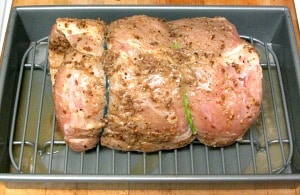
Preheat your oven to 325°, and calculate 30 minutes per pound. This was just over two pounds, and indeed took just over one hour to reach an internal temperature of 145°. Typically I would put a rolled roast with the fat side up, and the seam down, but in this case I opt to put the seam up to prevent further oozing out of seasoning mix. Pop your pan into the hot oven, and roast. A little before your predicted time, check it with a thermometer – if it is done, take it out, if not, give it some more time.
When it is done, take it out and let it rest for at least five to ten minutes – this both allows the meat to reabsorb juices and helps it firm up in the rolled position so that it is less apt to unroll when you remove the ties. Then slice and serve!
The rolled roast looks fussier than it is – and tastes delicious. I like to bake potatoes in the same oven, and simmer cabbage, red or green, as side dishes, as they go well with the spice mixture. The meat is wonderful cold, as well, or reheated as leftovers, so don’t worry if you have a small family – just think how impressed your coworkers will be when they see this in your lunchbox!
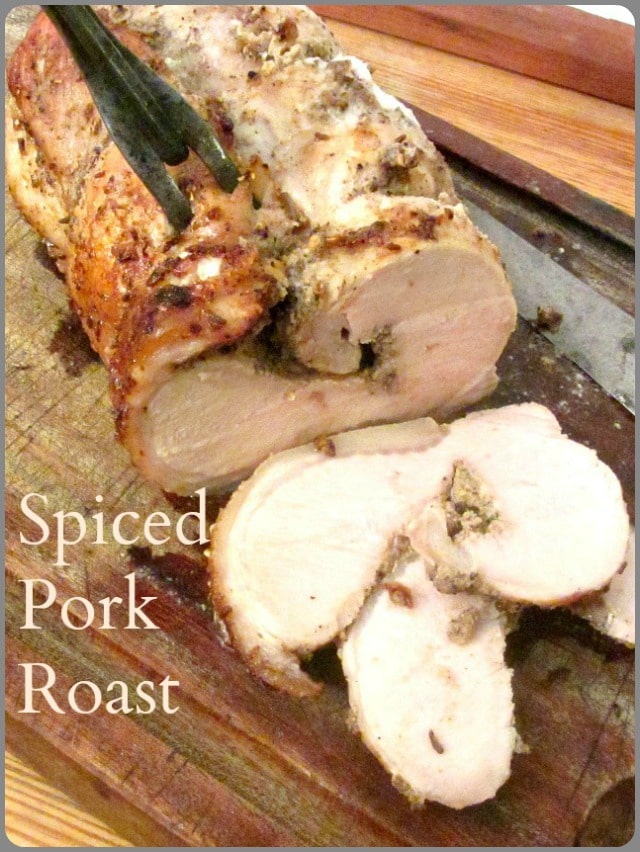
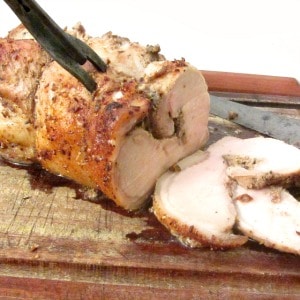
Spiced Pork Roast
Ingredients
- 1 t caraway
- 1 t coriander seeds
- 1/2 t black peppercorns
- 1/4 t salt
- 2-4 cloves garlic
- 3 T red wine vinegar
- 2 lb. pork loin roast
Instructions
- Several hours before you plan to roast the meat, grind the caraway, coriander, peppercorns, and salt together. Then blend with the garlic and vinegar until it comes into a paste. Set aside.
- Butterfly the pork loin,and spread with the spice mixture. Roll the meat, and fasten in a compact rolled roast. Take any spice blend that has oozed out and rub it into the outside of the roast.
- Cover and refrigerate several hours, to marinate.
- Roast in a preheated 325 oven for half an hour per pound, until it reaches an internal temperature of 145.
- Remove from the oven, and let rest 10 minutes before removing ties and slicing.
Notes

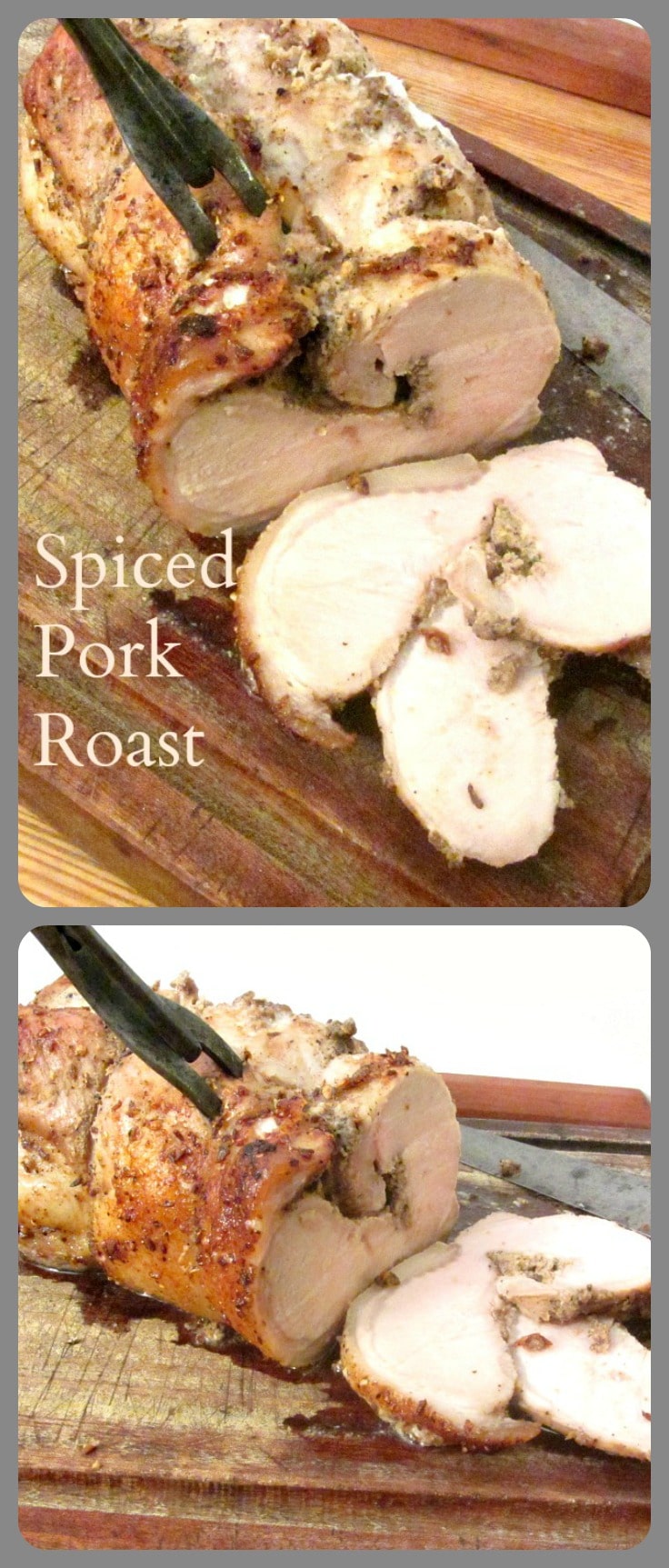
I think this is the first time I’ve ever read your blog, and I feel completely entertained, – in fact, I feel a little bit smarter! Not only did you give us a gorgeous pork recipe, but a food history lesson as well. I’m pleasantly surprised! Pork is by far my favourite type of meat, so I’m saving this recipe for later use. Thank you!
I think you have commented before (at any rate my spam filters think so LOL) but I don’t usually give the history lesson, so I can see that you might not connect them! I’m glad you found it interesting and entertaining!
I’ve just loved this seasoning combination for pork ever since I first tried it, and wanted to share it. I hope you enjoy it!
It’s so neat when people recreate historic recipes! It’s fun reading what ingredients they had to swap out when they can’t find certain things anymore. This looks delicious and simple to prepare!!
Thank you! I really love learning things like that – we all have to eat, but what we choose to eat (in the context, as you say, of what is available to us) is fascinating. (American cuisine is based almost entirely on that sort of swap – starting with cornmeal, and going on from there.)
This really is easy, but it looks as if you fussed a lot – nice for a dinner party.
Did you ever watch the BBC series The Supersizers Go? It would be right up your alley! Recipes from different historical eras are served to them, and they even wear clothes from the period. You can catch it on Hulu or YouTube. You could get a job with them!
No, I don’t know that one – I’ll have to look out for it! Thank you!
I do follow, on Twitter, the cooks working at Hampton Court in England – they experiment with Tudor technique, mostly (though they recently opened another kitchen – Georgian, I think?) and do have specific days when they demonstrate for the public. They’re really cool. I think it’s a lot of fun!
Interesting read! Especially when you think about pepper having to be imported. I love the combination of seasonings you used here. With those I know this has to be delicious.
Thank you!
It’s easy to forget how exotic pepper was. Not something you’d find on the common table of every inn! And we’re so casual about it… And at the same time, we’ve almost forgotten how good caraway is. But this really is a terrific combination of seasoning, and it complements the pork beautifully.
I love roasted pork!!
Oh, so do I! Even totally unseasoned it is good, and so versatile, and then it takes seasoning so well!
I’m a history buff! Love how you’ve transformed this into a simple recipe! I couldn’t agree more with the red wine vinegar substitute! I hate opening a bottle for just a few spoonfuls!
I know, right? I’m just not going to do that… For the original recipe and full marinade, sure, vinegar would be too acidic in that quantity, but for this? And actually, I think the vinegar worked better in this, since I needed so little – I wanted the more forceful flavor (and higher acid content.)
And isn’t history fun?
And thank you!
I love the history lesson. I find the history of food fascinating, particularly how foods have moved around the world with people migration. I often write about it as well. Such a fun way to experiment with new ingredients.
And I love this cut of pork roast, such a convenient cut to cook with and it just asks to be stuffed and/or marinated. Nice job.
Thank you! Yes, in fact I just read your latest about Charleston! Isn’t food history fascinating?
And we eat pork loin all the time – either chops or roast. It’s such a beautiful base for added flavor (while tasting delicious itself!) and so easy to cook.
The hubs is a huge fan of pork roast and it’s something I don’t get to cook with much. I know he’ll just love this recipe as it’s so full of flavor and juicy sounding. Maybe he’ll be able to surprise me and cook this on his day off next!
LOL, Much as I like to cook, I agree, there is nothing like having someone else do it, once in a while!
And I hope you both enjoy it.
So I go to a renaissance festival every few years or so, and they always have this massive feast called The King’s Feast. Has everything you can think of, down to the whole roast pig with an apple in its mouth. They serve a dish very similar to this. I always thought they used movies or shows (rarely actual history) to put together these feasts, but after reading your post I think I might be wrong!
This recipe sounds wonderful, and the history behind it is fascinating! Great stuff!
LOL – Renn Faires vary considerably – and it may even be a mix! But the original recipe – Cormarye – takes a lot less guesswork than some, and has been readily available for a while (because of the 18th Century printed version) so it’s likely enough. And while it’s not a precise combination of spices we are used to, it also doesn’t taste “weird” to the less adventurous patron (which is an issue for the Faires.)
Glad to provide something interesting!
We tend to make pork roast only on special occasions but this is a fantastic recipe for any dinner! Love it!
You know – I made meatballs last week, too, and this was both less expensive and easier. Huh.
I’m not quite where I’m going to do the stuff and roll thing for a weeknight dinner (well – I will, I’m a food blogger, but I mean, if I wasn’t writing about it… LOL) but this is easily Sunday Dinner material… Or, well, any time I want something even mildly festive or special.
And thank you!
Pork is one of my favorite meats to cooks. This looks so good & easy clean up too.
Wow, I loved learning all the history of the spices and preparation here on your post! I do love old cookbooks but find them rather hard to follow? The post looks stunning and very flavorful, will have to try your technique !
I know what you mean by hard to follow – many seem to have been written as memory aids for people who already knew the recipes, more than for people who’d never made them before! And of course, very few precise measurements even into the 20th Century. There is a certain amount of educated guessing involved – the trick is making sure it is, indeed, educated! I try to learn as much as I can about context, how people described food they liked, and so on.
And I hope you do try it, and enjoy it!
I am totally okay with you telling me to open a bottle of wine for three tablespoons, because it means I get to drink the rest of the wine with this amazing looking pork roast! Yes, please!
LOL – well, there’s that… Initially, I figured that if you were going to open the wine anyway, you would use it anyway, I just needed an option for those who would not. (And for myself – I can’t drink wine anymore.)
I found, though, that in the spice paste, the vinegar actually worked better (though I’d still use wine if I were doing the original marinade.)
And thank you!
This sounds SO good! I love the history lesson with this recipe and would love to hear more of this! You made me want to go look up historical recipes and give some of them a try! This sounds like a perfect Sunday dinner to serve my family.
Thank you! I always hope other people will find this as interesting as I do… and it seems they do!
And I hope you and your family enjoy it!
Thank you for that lesson. I learned a few things today. You made this sound so amazing now I want to try it. Don’t you find older recipe books a bit confusing sometimes. I feel like some of them assume you know what to do next haha.
Absolutely, many of them assume just that… Add enough… Cook until done.
The thing is, we do that, too… but of course we only do it for things when we do know what to do. How long do you steep your tea? How much cream do you put in your coffee? Well… enough… But it is awfully confusing when you don’t know what the end product is supposed to be like!
This, though, is an adaptation. I used, and so wanted to credit, the same combination of spice, but I totally changed the way it is used, and I do not know what proportions they used. But I know the result is different, because of the different technique.
I share your enthusiasm for history of food, l have purchased 2 books on this subject and they are fascinating. Your pork recipe is absolutely fantastic, in winter time, pork is the favourite meat in Romania and this dish would be highly appreciated. We also love caraway seeds, they bring such a lovely flavour to any dish.
Caraway seeds are so underused here in the US… I’m trying to pay more attention to them, and find more places to use them!
I was in Romania in the summer – decades ago, this was… I only ate Table D’Hote at the hotels we stayed at, and wasn’t always told what was being served (I was part of a group) and I’m sure the food was not typical – but I do seem to remember quite a bit of pork then, too. (Though it’s the mamaliga and the wonderful yogurt that really stand out in my memory!)
I have always cooked with red wine so I can just taste the deliciousness of this roast pork! Love the tidbits of history and my English hubby will be glad this has British origins!
Thank you!
Though in this recipe, do try the vinegar – I think it actually works better than wine in the smaller amount.
Pork is so good when it’s treated like royalty! This proves it! I have never butterflied a pork roast before, I should definitely try it!
I butterflied a roast for the first time a few years ago – and was amazed how easy it really is. I love techniques that are easy but look impressive! Do try it! I did a roast stuffed with vegetables and herbs a while back, too… Very different effect, also simpler than it seems. (That’s actually a slow cooker recipe.)
Definitely try it. And thanks!
This pork roast looks fantastic! I love your easy to follow instructions, since I’ve never made a pork roast before! What a great idea to use caraway seeds! I’m going to add this to my dinner rotation!
Thank you!
And thanks – I try to be as clear as I can. I know my readers vary from highly experienced (and even trained) cooks to people who’ve barely set foot in a kitchen before (most somewhere in the middle, of course) – and I know that even experienced cooks may not have made a specific kind of food. (You should have seen me making my first meatloaf…)
I do have an even easier recipe for a plain pork roast on the blog – which was a request from a friend! You really can’t go wrong with roast pork… But I like adding the seasoning.
I hope you enjoy it!
Interesting read! I always want to research about history of each food! Love your post and the way you talk about food!
Thank you so much! Isn’t it fascinating, seeing who ate what, and how, and why?
I am so glad to see a pork recipe that looks this good! Pork has a bad wrap but it has so much protein and good flavor. Good job!
Thank you!
Yes, we eat pork often – most often either the loin, as here, or the shoulder. Loin is really quite lean, both are delicious, they take seasoning beautifully… I enjoy cooking with them.